HR Development: Learning Styles, Training Needs & Evaluation-HSBC
VerifiedAdded on 2020/01/21
|16
|4847
|111
Report
AI Summary
This report provides a comprehensive overview of human resource development, focusing on different learning styles such as Kolb's and Honey and Mumford's, and their application within organizations like HSBC. It examines the role of the learning curve and the importance of transferring lea...
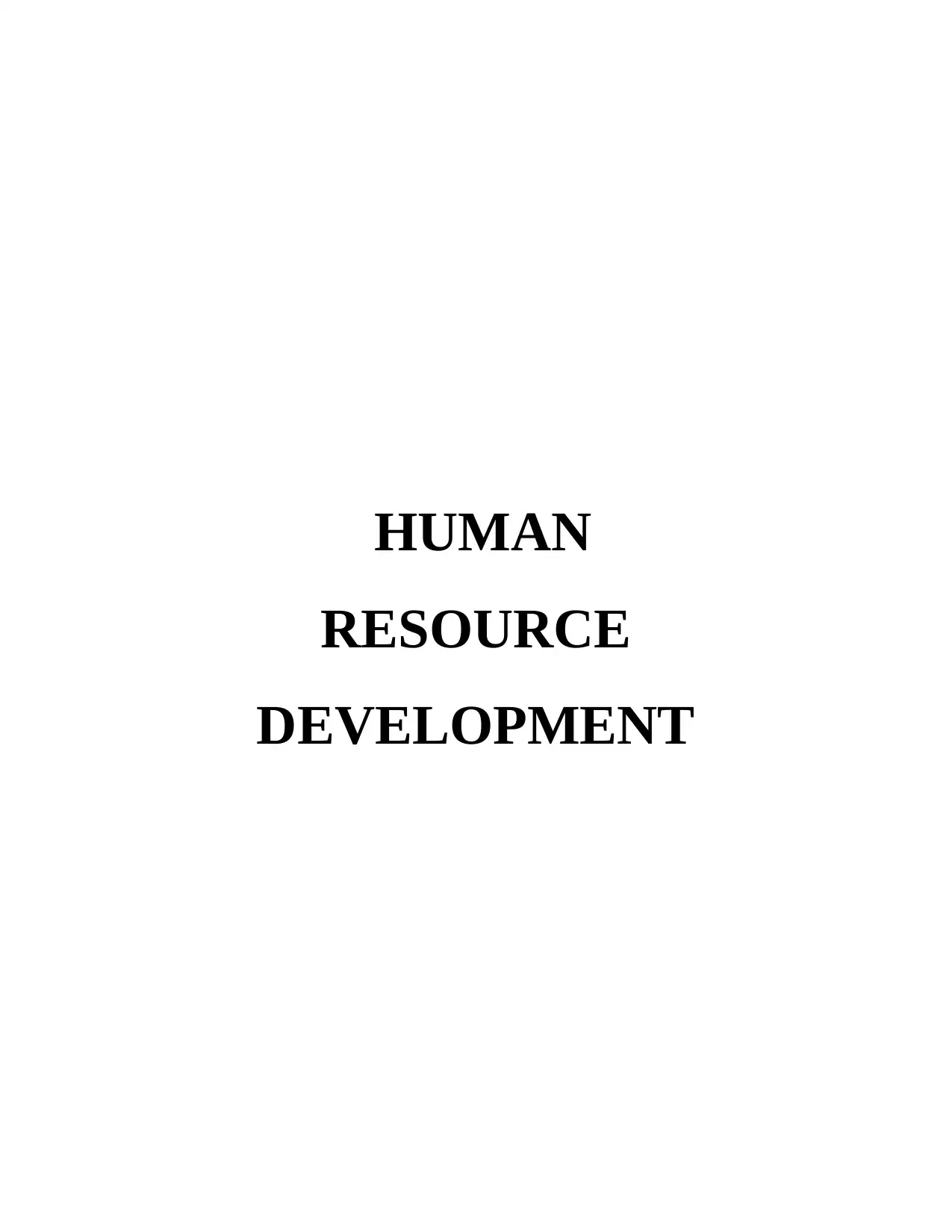
HUMAN
RESOURCE
DEVELOPMENT
RESOURCE
DEVELOPMENT
Paraphrase This Document
Need a fresh take? Get an instant paraphrase of this document with our AI Paraphraser
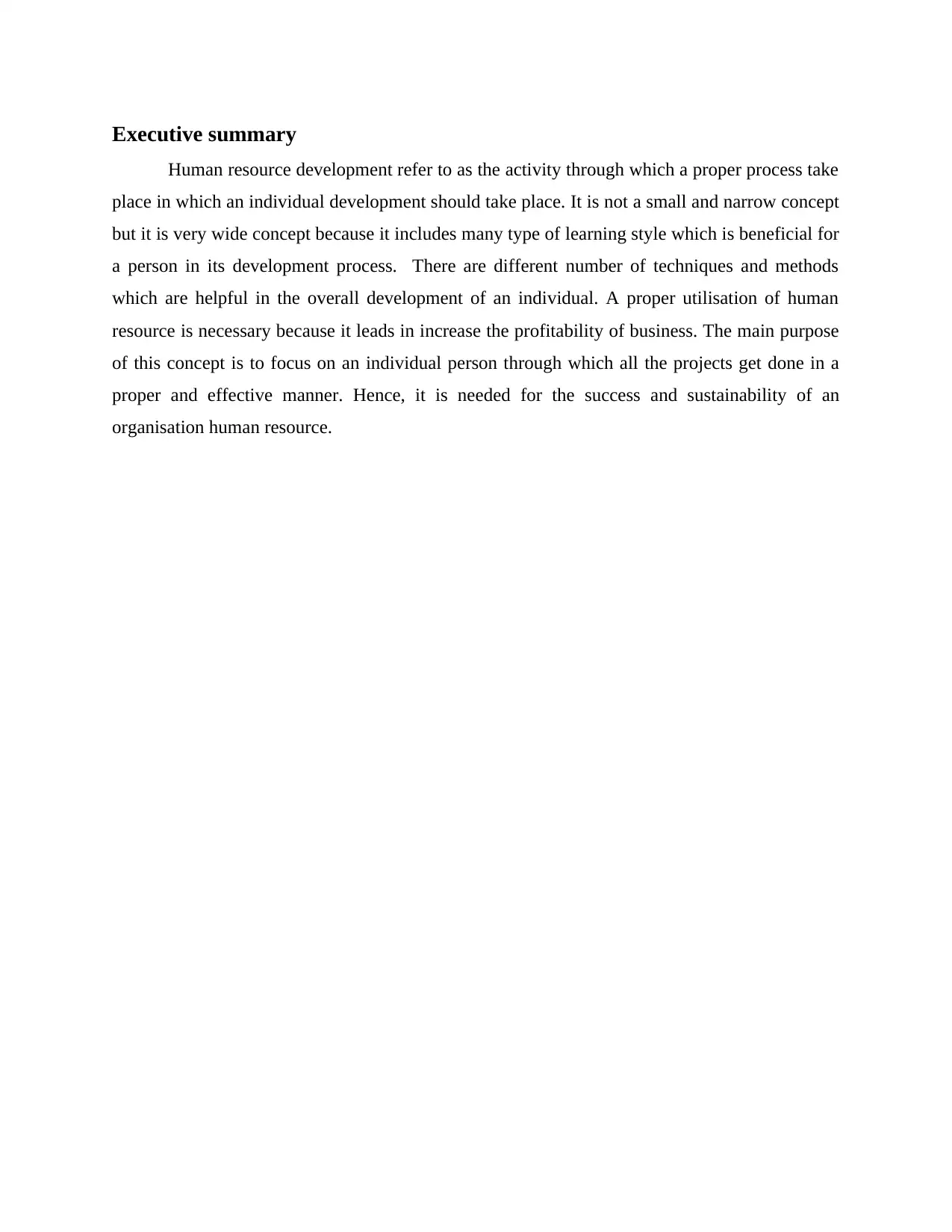
Executive summary
Human resource development refer to as the activity through which a proper process take
place in which an individual development should take place. It is not a small and narrow concept
but it is very wide concept because it includes many type of learning style which is beneficial for
a person in its development process. There are different number of techniques and methods
which are helpful in the overall development of an individual. A proper utilisation of human
resource is necessary because it leads in increase the profitability of business. The main purpose
of this concept is to focus on an individual person through which all the projects get done in a
proper and effective manner. Hence, it is needed for the success and sustainability of an
organisation human resource.
Human resource development refer to as the activity through which a proper process take
place in which an individual development should take place. It is not a small and narrow concept
but it is very wide concept because it includes many type of learning style which is beneficial for
a person in its development process. There are different number of techniques and methods
which are helpful in the overall development of an individual. A proper utilisation of human
resource is necessary because it leads in increase the profitability of business. The main purpose
of this concept is to focus on an individual person through which all the projects get done in a
proper and effective manner. Hence, it is needed for the success and sustainability of an
organisation human resource.

Table of Contents
Executive summary..........................................................................................................................2
INTRODUCTION...........................................................................................................................4
TASK 1............................................................................................................................................4
1.1 & M1 Comparing different learning styles......................................................................4
1.2 The role of the learning curve and the importance of transferring the learning style to the
workplace...............................................................................................................................5
1.3 & D1 Assessing the understanding of the learning styles and theories contribute to
designing the induction programme for HSBC......................................................................6
TASK 2............................................................................................................................................7
2.1 Listing and comparing the training needs of managerial staff employed at HSBC at
different levels focusing on the needs of less experienced managers....................................7
2.2 & M2 Assessment of the advantages and disadvantages of the training methods during the
training course........................................................................................................................8
2.3 & D2 Needs of training based on the areas, use of systematic approach to plan a training
and development programme for the event............................................................................9
TASK 3..........................................................................................................................................10
3.1 Preparing an evaluation using suitable techniques.........................................................10
3.2 & M3 Carrying out an evaluation of a training event....................................................11
3.3 Reviewing the success of the evaluation methods used.................................................11
TASK 4..........................................................................................................................................12
4.1 The role of government in training and development in UK, including lifelong learning.12
4.2 The need of competency and skills assessments impacted the public and private sectors.12
4.3 & D3 The contemporary government initiatives on training and development have
contributed to human resource development in UK.............................................................13
CONCLUSION..............................................................................................................................13
REFERENCES..............................................................................................................................15
Executive summary..........................................................................................................................2
INTRODUCTION...........................................................................................................................4
TASK 1............................................................................................................................................4
1.1 & M1 Comparing different learning styles......................................................................4
1.2 The role of the learning curve and the importance of transferring the learning style to the
workplace...............................................................................................................................5
1.3 & D1 Assessing the understanding of the learning styles and theories contribute to
designing the induction programme for HSBC......................................................................6
TASK 2............................................................................................................................................7
2.1 Listing and comparing the training needs of managerial staff employed at HSBC at
different levels focusing on the needs of less experienced managers....................................7
2.2 & M2 Assessment of the advantages and disadvantages of the training methods during the
training course........................................................................................................................8
2.3 & D2 Needs of training based on the areas, use of systematic approach to plan a training
and development programme for the event............................................................................9
TASK 3..........................................................................................................................................10
3.1 Preparing an evaluation using suitable techniques.........................................................10
3.2 & M3 Carrying out an evaluation of a training event....................................................11
3.3 Reviewing the success of the evaluation methods used.................................................11
TASK 4..........................................................................................................................................12
4.1 The role of government in training and development in UK, including lifelong learning.12
4.2 The need of competency and skills assessments impacted the public and private sectors.12
4.3 & D3 The contemporary government initiatives on training and development have
contributed to human resource development in UK.............................................................13
CONCLUSION..............................................................................................................................13
REFERENCES..............................................................................................................................15
⊘ This is a preview!⊘
Do you want full access?
Subscribe today to unlock all pages.

Trusted by 1+ million students worldwide
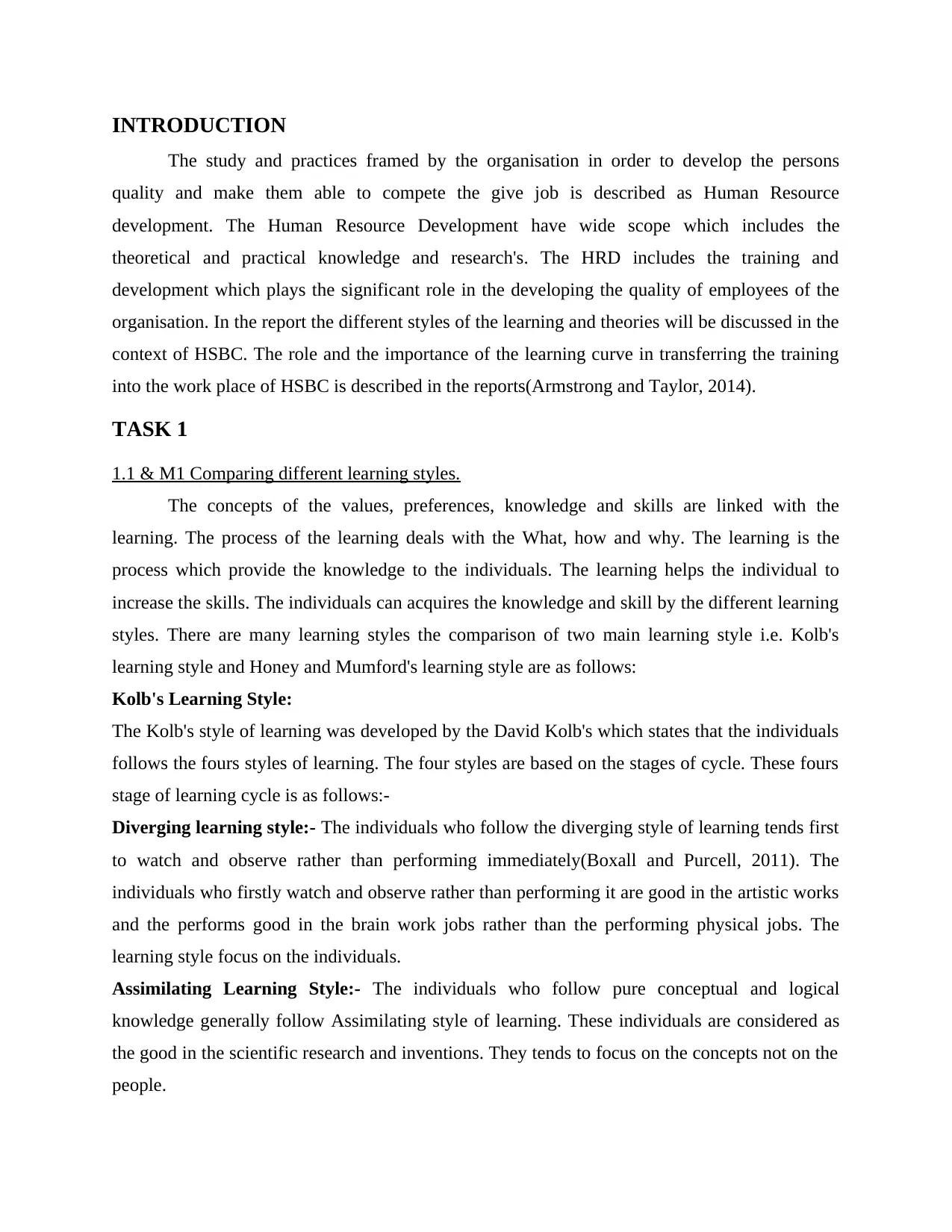
INTRODUCTION
The study and practices framed by the organisation in order to develop the persons
quality and make them able to compete the give job is described as Human Resource
development. The Human Resource Development have wide scope which includes the
theoretical and practical knowledge and research's. The HRD includes the training and
development which plays the significant role in the developing the quality of employees of the
organisation. In the report the different styles of the learning and theories will be discussed in the
context of HSBC. The role and the importance of the learning curve in transferring the training
into the work place of HSBC is described in the reports(Armstrong and Taylor, 2014).
TASK 1
1.1 & M1 Comparing different learning styles.
The concepts of the values, preferences, knowledge and skills are linked with the
learning. The process of the learning deals with the What, how and why. The learning is the
process which provide the knowledge to the individuals. The learning helps the individual to
increase the skills. The individuals can acquires the knowledge and skill by the different learning
styles. There are many learning styles the comparison of two main learning style i.e. Kolb's
learning style and Honey and Mumford's learning style are as follows:
Kolb's Learning Style:
The Kolb's style of learning was developed by the David Kolb's which states that the individuals
follows the fours styles of learning. The four styles are based on the stages of cycle. These fours
stage of learning cycle is as follows:-
Diverging learning style:- The individuals who follow the diverging style of learning tends first
to watch and observe rather than performing immediately(Boxall and Purcell, 2011). The
individuals who firstly watch and observe rather than performing it are good in the artistic works
and the performs good in the brain work jobs rather than the performing physical jobs. The
learning style focus on the individuals.
Assimilating Learning Style:- The individuals who follow pure conceptual and logical
knowledge generally follow Assimilating style of learning. These individuals are considered as
the good in the scientific research and inventions. They tends to focus on the concepts not on the
people.
The study and practices framed by the organisation in order to develop the persons
quality and make them able to compete the give job is described as Human Resource
development. The Human Resource Development have wide scope which includes the
theoretical and practical knowledge and research's. The HRD includes the training and
development which plays the significant role in the developing the quality of employees of the
organisation. In the report the different styles of the learning and theories will be discussed in the
context of HSBC. The role and the importance of the learning curve in transferring the training
into the work place of HSBC is described in the reports(Armstrong and Taylor, 2014).
TASK 1
1.1 & M1 Comparing different learning styles.
The concepts of the values, preferences, knowledge and skills are linked with the
learning. The process of the learning deals with the What, how and why. The learning is the
process which provide the knowledge to the individuals. The learning helps the individual to
increase the skills. The individuals can acquires the knowledge and skill by the different learning
styles. There are many learning styles the comparison of two main learning style i.e. Kolb's
learning style and Honey and Mumford's learning style are as follows:
Kolb's Learning Style:
The Kolb's style of learning was developed by the David Kolb's which states that the individuals
follows the fours styles of learning. The four styles are based on the stages of cycle. These fours
stage of learning cycle is as follows:-
Diverging learning style:- The individuals who follow the diverging style of learning tends first
to watch and observe rather than performing immediately(Boxall and Purcell, 2011). The
individuals who firstly watch and observe rather than performing it are good in the artistic works
and the performs good in the brain work jobs rather than the performing physical jobs. The
learning style focus on the individuals.
Assimilating Learning Style:- The individuals who follow pure conceptual and logical
knowledge generally follow Assimilating style of learning. These individuals are considered as
the good in the scientific research and inventions. They tends to focus on the concepts not on the
people.
Paraphrase This Document
Need a fresh take? Get an instant paraphrase of this document with our AI Paraphraser
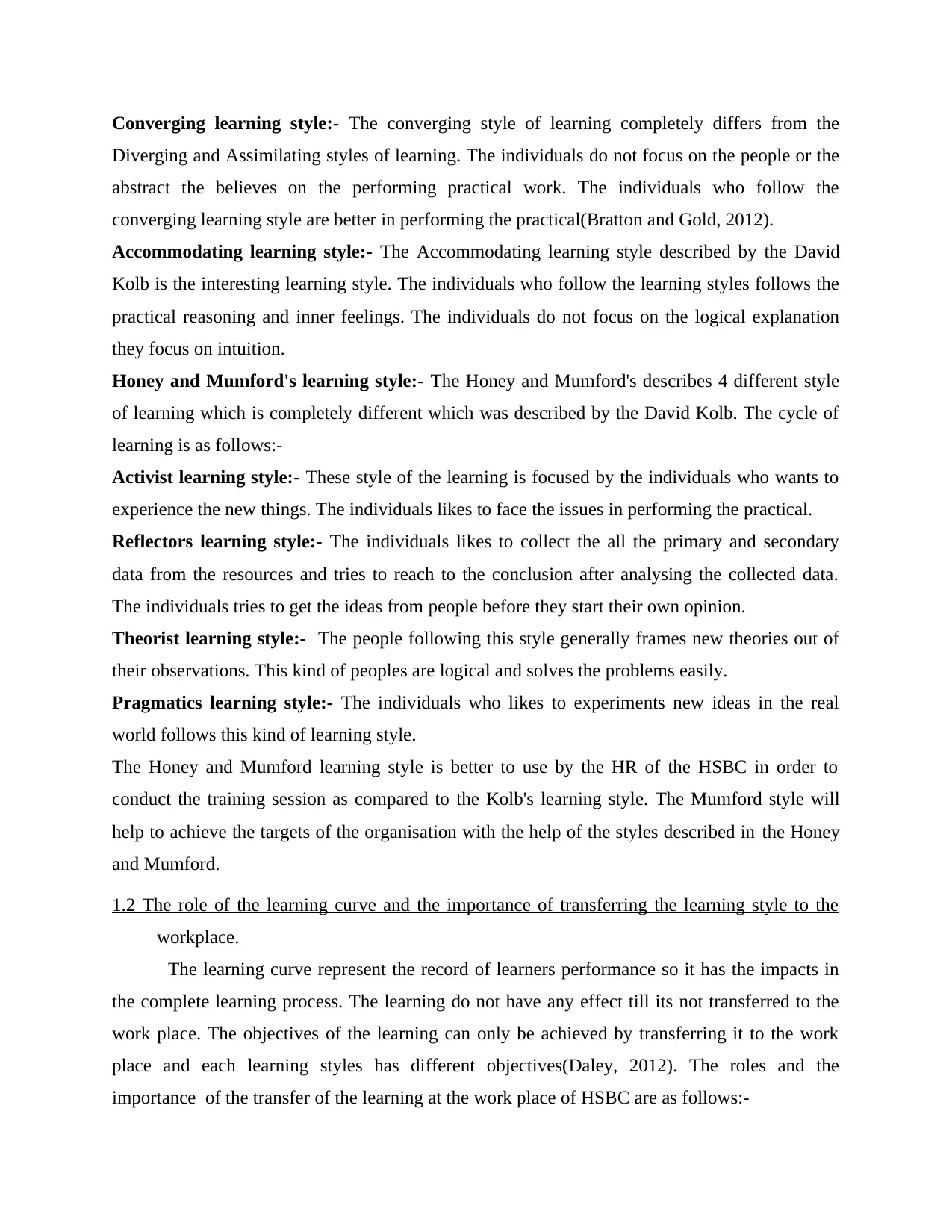
Converging learning style:- The converging style of learning completely differs from the
Diverging and Assimilating styles of learning. The individuals do not focus on the people or the
abstract the believes on the performing practical work. The individuals who follow the
converging learning style are better in performing the practical(Bratton and Gold, 2012).
Accommodating learning style:- The Accommodating learning style described by the David
Kolb is the interesting learning style. The individuals who follow the learning styles follows the
practical reasoning and inner feelings. The individuals do not focus on the logical explanation
they focus on intuition.
Honey and Mumford's learning style:- The Honey and Mumford's describes 4 different style
of learning which is completely different which was described by the David Kolb. The cycle of
learning is as follows:-
Activist learning style:- These style of the learning is focused by the individuals who wants to
experience the new things. The individuals likes to face the issues in performing the practical.
Reflectors learning style:- The individuals likes to collect the all the primary and secondary
data from the resources and tries to reach to the conclusion after analysing the collected data.
The individuals tries to get the ideas from people before they start their own opinion.
Theorist learning style:- The people following this style generally frames new theories out of
their observations. This kind of peoples are logical and solves the problems easily.
Pragmatics learning style:- The individuals who likes to experiments new ideas in the real
world follows this kind of learning style.
The Honey and Mumford learning style is better to use by the HR of the HSBC in order to
conduct the training session as compared to the Kolb's learning style. The Mumford style will
help to achieve the targets of the organisation with the help of the styles described in the Honey
and Mumford.
1.2 The role of the learning curve and the importance of transferring the learning style to the
workplace.
The learning curve represent the record of learners performance so it has the impacts in
the complete learning process. The learning do not have any effect till its not transferred to the
work place. The objectives of the learning can only be achieved by transferring it to the work
place and each learning styles has different objectives(Daley, 2012). The roles and the
importance of the transfer of the learning at the work place of HSBC are as follows:-
Diverging and Assimilating styles of learning. The individuals do not focus on the people or the
abstract the believes on the performing practical work. The individuals who follow the
converging learning style are better in performing the practical(Bratton and Gold, 2012).
Accommodating learning style:- The Accommodating learning style described by the David
Kolb is the interesting learning style. The individuals who follow the learning styles follows the
practical reasoning and inner feelings. The individuals do not focus on the logical explanation
they focus on intuition.
Honey and Mumford's learning style:- The Honey and Mumford's describes 4 different style
of learning which is completely different which was described by the David Kolb. The cycle of
learning is as follows:-
Activist learning style:- These style of the learning is focused by the individuals who wants to
experience the new things. The individuals likes to face the issues in performing the practical.
Reflectors learning style:- The individuals likes to collect the all the primary and secondary
data from the resources and tries to reach to the conclusion after analysing the collected data.
The individuals tries to get the ideas from people before they start their own opinion.
Theorist learning style:- The people following this style generally frames new theories out of
their observations. This kind of peoples are logical and solves the problems easily.
Pragmatics learning style:- The individuals who likes to experiments new ideas in the real
world follows this kind of learning style.
The Honey and Mumford learning style is better to use by the HR of the HSBC in order to
conduct the training session as compared to the Kolb's learning style. The Mumford style will
help to achieve the targets of the organisation with the help of the styles described in the Honey
and Mumford.
1.2 The role of the learning curve and the importance of transferring the learning style to the
workplace.
The learning curve represent the record of learners performance so it has the impacts in
the complete learning process. The learning do not have any effect till its not transferred to the
work place. The objectives of the learning can only be achieved by transferring it to the work
place and each learning styles has different objectives(Daley, 2012). The roles and the
importance of the transfer of the learning at the work place of HSBC are as follows:-
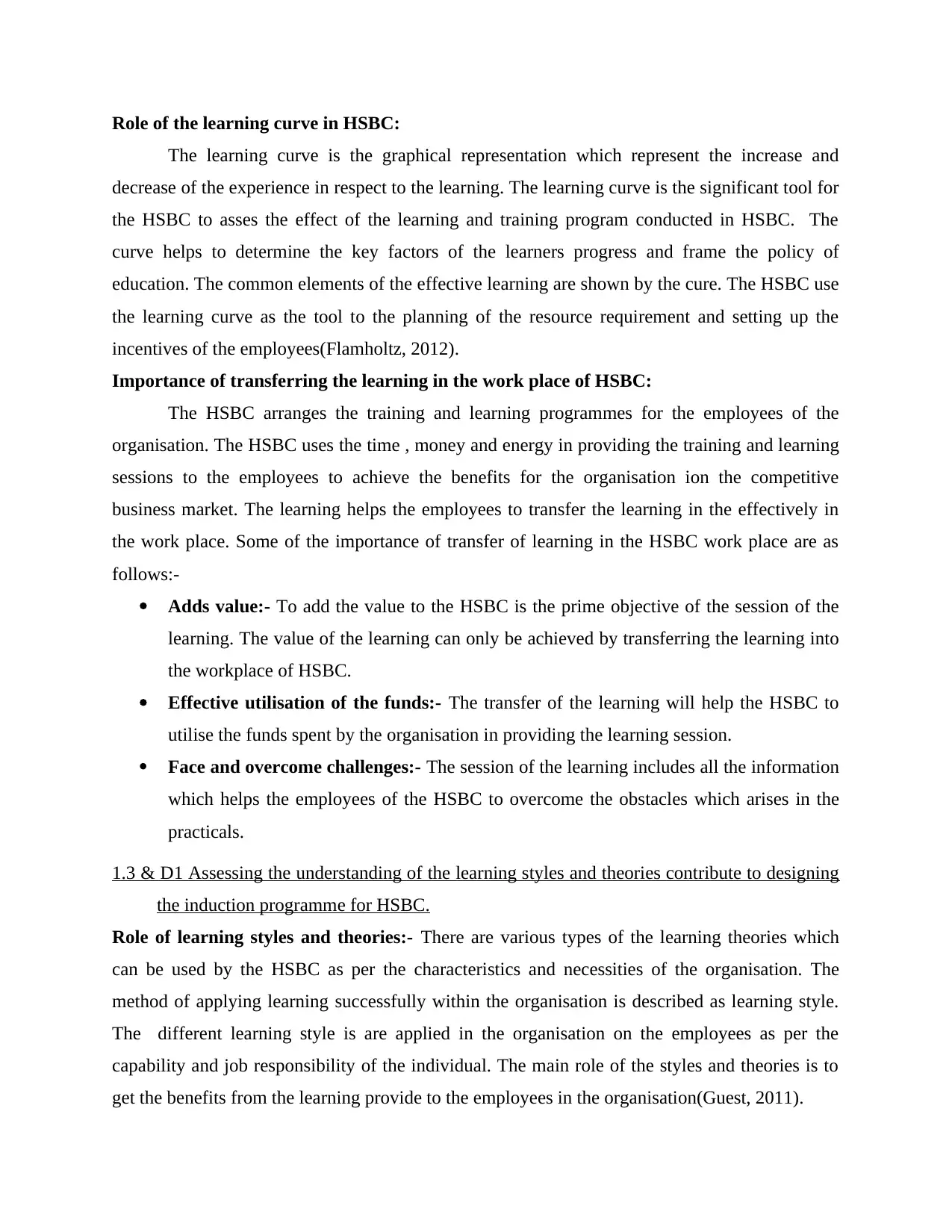
Role of the learning curve in HSBC:
The learning curve is the graphical representation which represent the increase and
decrease of the experience in respect to the learning. The learning curve is the significant tool for
the HSBC to asses the effect of the learning and training program conducted in HSBC. The
curve helps to determine the key factors of the learners progress and frame the policy of
education. The common elements of the effective learning are shown by the cure. The HSBC use
the learning curve as the tool to the planning of the resource requirement and setting up the
incentives of the employees(Flamholtz, 2012).
Importance of transferring the learning in the work place of HSBC:
The HSBC arranges the training and learning programmes for the employees of the
organisation. The HSBC uses the time , money and energy in providing the training and learning
sessions to the employees to achieve the benefits for the organisation ion the competitive
business market. The learning helps the employees to transfer the learning in the effectively in
the work place. Some of the importance of transfer of learning in the HSBC work place are as
follows:-
Adds value:- To add the value to the HSBC is the prime objective of the session of the
learning. The value of the learning can only be achieved by transferring the learning into
the workplace of HSBC.
Effective utilisation of the funds:- The transfer of the learning will help the HSBC to
utilise the funds spent by the organisation in providing the learning session.
Face and overcome challenges:- The session of the learning includes all the information
which helps the employees of the HSBC to overcome the obstacles which arises in the
practicals.
1.3 & D1 Assessing the understanding of the learning styles and theories contribute to designing
the induction programme for HSBC.
Role of learning styles and theories:- There are various types of the learning theories which
can be used by the HSBC as per the characteristics and necessities of the organisation. The
method of applying learning successfully within the organisation is described as learning style.
The different learning style is are applied in the organisation on the employees as per the
capability and job responsibility of the individual. The main role of the styles and theories is to
get the benefits from the learning provide to the employees in the organisation(Guest, 2011).
The learning curve is the graphical representation which represent the increase and
decrease of the experience in respect to the learning. The learning curve is the significant tool for
the HSBC to asses the effect of the learning and training program conducted in HSBC. The
curve helps to determine the key factors of the learners progress and frame the policy of
education. The common elements of the effective learning are shown by the cure. The HSBC use
the learning curve as the tool to the planning of the resource requirement and setting up the
incentives of the employees(Flamholtz, 2012).
Importance of transferring the learning in the work place of HSBC:
The HSBC arranges the training and learning programmes for the employees of the
organisation. The HSBC uses the time , money and energy in providing the training and learning
sessions to the employees to achieve the benefits for the organisation ion the competitive
business market. The learning helps the employees to transfer the learning in the effectively in
the work place. Some of the importance of transfer of learning in the HSBC work place are as
follows:-
Adds value:- To add the value to the HSBC is the prime objective of the session of the
learning. The value of the learning can only be achieved by transferring the learning into
the workplace of HSBC.
Effective utilisation of the funds:- The transfer of the learning will help the HSBC to
utilise the funds spent by the organisation in providing the learning session.
Face and overcome challenges:- The session of the learning includes all the information
which helps the employees of the HSBC to overcome the obstacles which arises in the
practicals.
1.3 & D1 Assessing the understanding of the learning styles and theories contribute to designing
the induction programme for HSBC.
Role of learning styles and theories:- There are various types of the learning theories which
can be used by the HSBC as per the characteristics and necessities of the organisation. The
method of applying learning successfully within the organisation is described as learning style.
The different learning style is are applied in the organisation on the employees as per the
capability and job responsibility of the individual. The main role of the styles and theories is to
get the benefits from the learning provide to the employees in the organisation(Guest, 2011).
⊘ This is a preview!⊘
Do you want full access?
Subscribe today to unlock all pages.

Trusted by 1+ million students worldwide
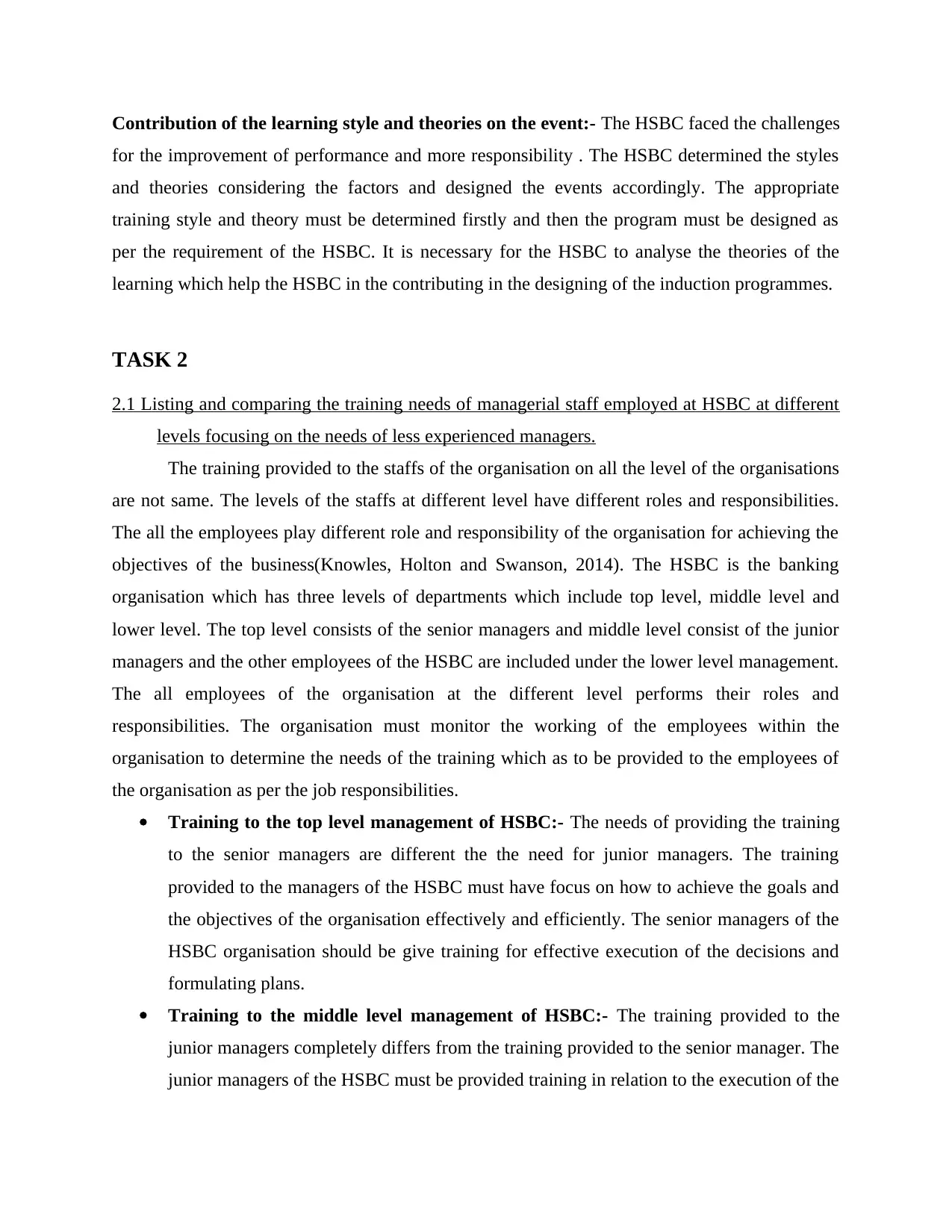
Contribution of the learning style and theories on the event:- The HSBC faced the challenges
for the improvement of performance and more responsibility . The HSBC determined the styles
and theories considering the factors and designed the events accordingly. The appropriate
training style and theory must be determined firstly and then the program must be designed as
per the requirement of the HSBC. It is necessary for the HSBC to analyse the theories of the
learning which help the HSBC in the contributing in the designing of the induction programmes.
TASK 2
2.1 Listing and comparing the training needs of managerial staff employed at HSBC at different
levels focusing on the needs of less experienced managers.
The training provided to the staffs of the organisation on all the level of the organisations
are not same. The levels of the staffs at different level have different roles and responsibilities.
The all the employees play different role and responsibility of the organisation for achieving the
objectives of the business(Knowles, Holton and Swanson, 2014). The HSBC is the banking
organisation which has three levels of departments which include top level, middle level and
lower level. The top level consists of the senior managers and middle level consist of the junior
managers and the other employees of the HSBC are included under the lower level management.
The all employees of the organisation at the different level performs their roles and
responsibilities. The organisation must monitor the working of the employees within the
organisation to determine the needs of the training which as to be provided to the employees of
the organisation as per the job responsibilities.
Training to the top level management of HSBC:- The needs of providing the training
to the senior managers are different the the need for junior managers. The training
provided to the managers of the HSBC must have focus on how to achieve the goals and
the objectives of the organisation effectively and efficiently. The senior managers of the
HSBC organisation should be give training for effective execution of the decisions and
formulating plans.
Training to the middle level management of HSBC:- The training provided to the
junior managers completely differs from the training provided to the senior manager. The
junior managers of the HSBC must be provided training in relation to the execution of the
for the improvement of performance and more responsibility . The HSBC determined the styles
and theories considering the factors and designed the events accordingly. The appropriate
training style and theory must be determined firstly and then the program must be designed as
per the requirement of the HSBC. It is necessary for the HSBC to analyse the theories of the
learning which help the HSBC in the contributing in the designing of the induction programmes.
TASK 2
2.1 Listing and comparing the training needs of managerial staff employed at HSBC at different
levels focusing on the needs of less experienced managers.
The training provided to the staffs of the organisation on all the level of the organisations
are not same. The levels of the staffs at different level have different roles and responsibilities.
The all the employees play different role and responsibility of the organisation for achieving the
objectives of the business(Knowles, Holton and Swanson, 2014). The HSBC is the banking
organisation which has three levels of departments which include top level, middle level and
lower level. The top level consists of the senior managers and middle level consist of the junior
managers and the other employees of the HSBC are included under the lower level management.
The all employees of the organisation at the different level performs their roles and
responsibilities. The organisation must monitor the working of the employees within the
organisation to determine the needs of the training which as to be provided to the employees of
the organisation as per the job responsibilities.
Training to the top level management of HSBC:- The needs of providing the training
to the senior managers are different the the need for junior managers. The training
provided to the managers of the HSBC must have focus on how to achieve the goals and
the objectives of the organisation effectively and efficiently. The senior managers of the
HSBC organisation should be give training for effective execution of the decisions and
formulating plans.
Training to the middle level management of HSBC:- The training provided to the
junior managers completely differs from the training provided to the senior manager. The
junior managers of the HSBC must be provided training in relation to the execution of the
Paraphrase This Document
Need a fresh take? Get an instant paraphrase of this document with our AI Paraphraser
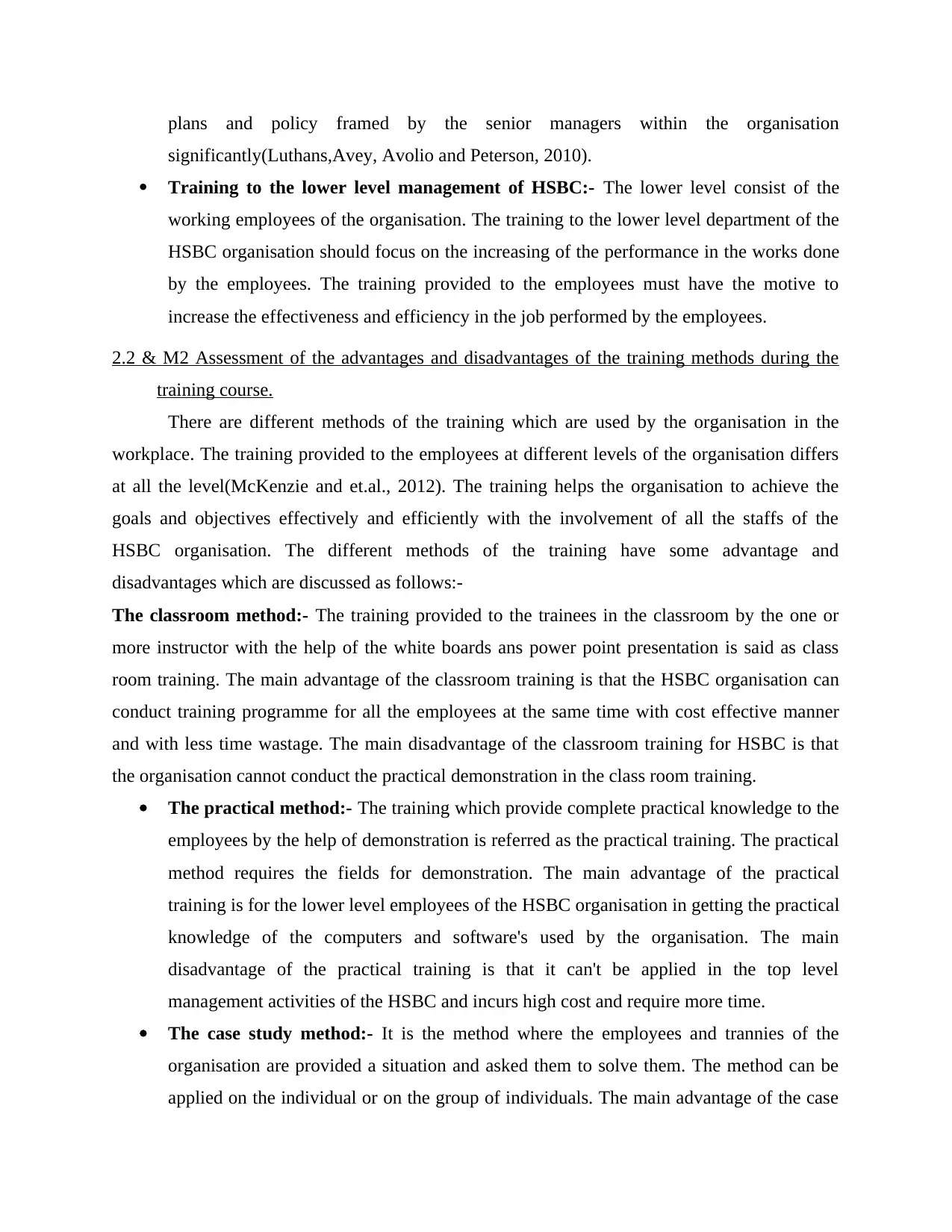
plans and policy framed by the senior managers within the organisation
significantly(Luthans,Avey, Avolio and Peterson, 2010).
Training to the lower level management of HSBC:- The lower level consist of the
working employees of the organisation. The training to the lower level department of the
HSBC organisation should focus on the increasing of the performance in the works done
by the employees. The training provided to the employees must have the motive to
increase the effectiveness and efficiency in the job performed by the employees.
2.2 & M2 Assessment of the advantages and disadvantages of the training methods during the
training course.
There are different methods of the training which are used by the organisation in the
workplace. The training provided to the employees at different levels of the organisation differs
at all the level(McKenzie and et.al., 2012). The training helps the organisation to achieve the
goals and objectives effectively and efficiently with the involvement of all the staffs of the
HSBC organisation. The different methods of the training have some advantage and
disadvantages which are discussed as follows:-
The classroom method:- The training provided to the trainees in the classroom by the one or
more instructor with the help of the white boards ans power point presentation is said as class
room training. The main advantage of the classroom training is that the HSBC organisation can
conduct training programme for all the employees at the same time with cost effective manner
and with less time wastage. The main disadvantage of the classroom training for HSBC is that
the organisation cannot conduct the practical demonstration in the class room training.
The practical method:- The training which provide complete practical knowledge to the
employees by the help of demonstration is referred as the practical training. The practical
method requires the fields for demonstration. The main advantage of the practical
training is for the lower level employees of the HSBC organisation in getting the practical
knowledge of the computers and software's used by the organisation. The main
disadvantage of the practical training is that it can't be applied in the top level
management activities of the HSBC and incurs high cost and require more time.
The case study method:- It is the method where the employees and trannies of the
organisation are provided a situation and asked them to solve them. The method can be
applied on the individual or on the group of individuals. The main advantage of the case
significantly(Luthans,Avey, Avolio and Peterson, 2010).
Training to the lower level management of HSBC:- The lower level consist of the
working employees of the organisation. The training to the lower level department of the
HSBC organisation should focus on the increasing of the performance in the works done
by the employees. The training provided to the employees must have the motive to
increase the effectiveness and efficiency in the job performed by the employees.
2.2 & M2 Assessment of the advantages and disadvantages of the training methods during the
training course.
There are different methods of the training which are used by the organisation in the
workplace. The training provided to the employees at different levels of the organisation differs
at all the level(McKenzie and et.al., 2012). The training helps the organisation to achieve the
goals and objectives effectively and efficiently with the involvement of all the staffs of the
HSBC organisation. The different methods of the training have some advantage and
disadvantages which are discussed as follows:-
The classroom method:- The training provided to the trainees in the classroom by the one or
more instructor with the help of the white boards ans power point presentation is said as class
room training. The main advantage of the classroom training is that the HSBC organisation can
conduct training programme for all the employees at the same time with cost effective manner
and with less time wastage. The main disadvantage of the classroom training for HSBC is that
the organisation cannot conduct the practical demonstration in the class room training.
The practical method:- The training which provide complete practical knowledge to the
employees by the help of demonstration is referred as the practical training. The practical
method requires the fields for demonstration. The main advantage of the practical
training is for the lower level employees of the HSBC organisation in getting the practical
knowledge of the computers and software's used by the organisation. The main
disadvantage of the practical training is that it can't be applied in the top level
management activities of the HSBC and incurs high cost and require more time.
The case study method:- It is the method where the employees and trannies of the
organisation are provided a situation and asked them to solve them. The method can be
applied on the individual or on the group of individuals. The main advantage of the case

study training method is the it can be applied on the top level management of the HSBC
to improve the decision making by the managers. The disadvantage of the method is that
it cannot be used in training to the subordinates of the employees(Reio, 2010).
The mix training methods:- The method in which all the methods of the training used to
train the employees are used as per the needs is said as mixed training method. The
mixed training method have significant advantage that the combined approach can be
applied to train the employees at the different levels of the HSBC organisation. The
mixed training method is very costly for the organisation and it requires more time which
is the main disadvantage to this training method(Vörösmarty and et.al., 2010).
2.3 & D2 Needs of training based on the areas, use of systematic approach to plan a training and
development programme for the event.
The systematic approach of training is composed in the steps and stages which is
performed one after another. The aim of the organisation must be predetermined before
providing the training to the employees of the organisation. The analysis of the employees and
determining the need of the training will help the HSBC to develop good and systematic training
programme. The systematic approach to plan the training event of the HSBC organisation is as
follows:-
Determining the aim of the organisation:- The aim of the HSBC organisation must be
predetermined which helps in selecting the appropriate method of training. The main aim
of the organisation is to provide more finance to the public and increase the number of
the service user of the HSBC.
Setting up training need:- In this stage the company must identify the need of the
training to the employees of the organisation. The determination of the need will help the
HSBC organisation to select the method which will be effective and efficient for the
organisation.
Designing the training strategy:- Once the organisation have analysed the aims of the
organisation and the need of the training, the HSBC selects the appropriate training
method in order to get the effective results form the funds and time used in providing the
training. The HSBC selects the demonstrative method of training for the lower level
management to increase the effectiveness and efficiency in the performance of the
employees. The demonstrative training strategy will help the organisation to get the
to improve the decision making by the managers. The disadvantage of the method is that
it cannot be used in training to the subordinates of the employees(Reio, 2010).
The mix training methods:- The method in which all the methods of the training used to
train the employees are used as per the needs is said as mixed training method. The
mixed training method have significant advantage that the combined approach can be
applied to train the employees at the different levels of the HSBC organisation. The
mixed training method is very costly for the organisation and it requires more time which
is the main disadvantage to this training method(Vörösmarty and et.al., 2010).
2.3 & D2 Needs of training based on the areas, use of systematic approach to plan a training and
development programme for the event.
The systematic approach of training is composed in the steps and stages which is
performed one after another. The aim of the organisation must be predetermined before
providing the training to the employees of the organisation. The analysis of the employees and
determining the need of the training will help the HSBC to develop good and systematic training
programme. The systematic approach to plan the training event of the HSBC organisation is as
follows:-
Determining the aim of the organisation:- The aim of the HSBC organisation must be
predetermined which helps in selecting the appropriate method of training. The main aim
of the organisation is to provide more finance to the public and increase the number of
the service user of the HSBC.
Setting up training need:- In this stage the company must identify the need of the
training to the employees of the organisation. The determination of the need will help the
HSBC organisation to select the method which will be effective and efficient for the
organisation.
Designing the training strategy:- Once the organisation have analysed the aims of the
organisation and the need of the training, the HSBC selects the appropriate training
method in order to get the effective results form the funds and time used in providing the
training. The HSBC selects the demonstrative method of training for the lower level
management to increase the effectiveness and efficiency in the performance of the
employees. The demonstrative training strategy will help the organisation to get the
⊘ This is a preview!⊘
Do you want full access?
Subscribe today to unlock all pages.

Trusted by 1+ million students worldwide
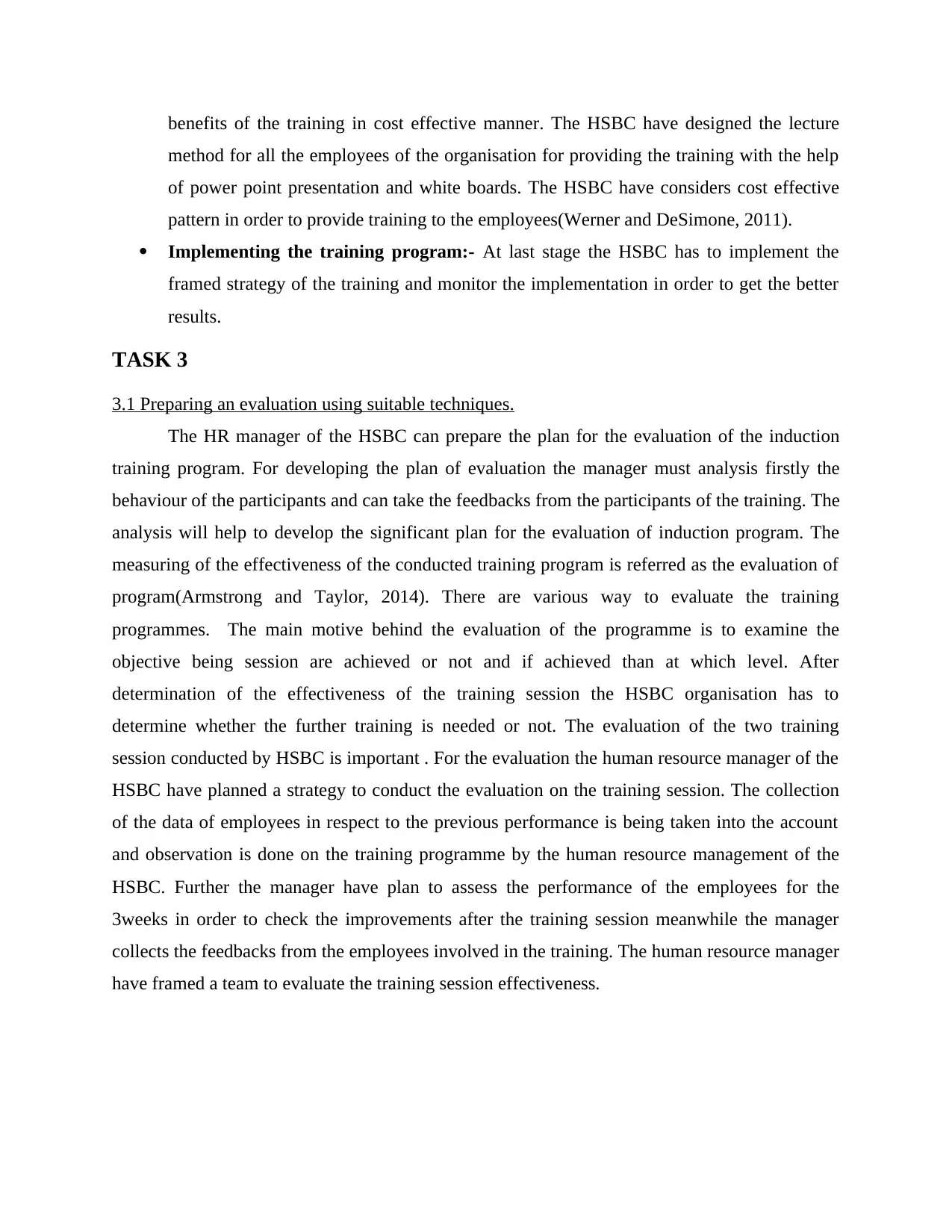
benefits of the training in cost effective manner. The HSBC have designed the lecture
method for all the employees of the organisation for providing the training with the help
of power point presentation and white boards. The HSBC have considers cost effective
pattern in order to provide training to the employees(Werner and DeSimone, 2011).
Implementing the training program:- At last stage the HSBC has to implement the
framed strategy of the training and monitor the implementation in order to get the better
results.
TASK 3
3.1 Preparing an evaluation using suitable techniques.
The HR manager of the HSBC can prepare the plan for the evaluation of the induction
training program. For developing the plan of evaluation the manager must analysis firstly the
behaviour of the participants and can take the feedbacks from the participants of the training. The
analysis will help to develop the significant plan for the evaluation of induction program. The
measuring of the effectiveness of the conducted training program is referred as the evaluation of
program(Armstrong and Taylor, 2014). There are various way to evaluate the training
programmes. The main motive behind the evaluation of the programme is to examine the
objective being session are achieved or not and if achieved than at which level. After
determination of the effectiveness of the training session the HSBC organisation has to
determine whether the further training is needed or not. The evaluation of the two training
session conducted by HSBC is important . For the evaluation the human resource manager of the
HSBC have planned a strategy to conduct the evaluation on the training session. The collection
of the data of employees in respect to the previous performance is being taken into the account
and observation is done on the training programme by the human resource management of the
HSBC. Further the manager have plan to assess the performance of the employees for the
3weeks in order to check the improvements after the training session meanwhile the manager
collects the feedbacks from the employees involved in the training. The human resource manager
have framed a team to evaluate the training session effectiveness.
method for all the employees of the organisation for providing the training with the help
of power point presentation and white boards. The HSBC have considers cost effective
pattern in order to provide training to the employees(Werner and DeSimone, 2011).
Implementing the training program:- At last stage the HSBC has to implement the
framed strategy of the training and monitor the implementation in order to get the better
results.
TASK 3
3.1 Preparing an evaluation using suitable techniques.
The HR manager of the HSBC can prepare the plan for the evaluation of the induction
training program. For developing the plan of evaluation the manager must analysis firstly the
behaviour of the participants and can take the feedbacks from the participants of the training. The
analysis will help to develop the significant plan for the evaluation of induction program. The
measuring of the effectiveness of the conducted training program is referred as the evaluation of
program(Armstrong and Taylor, 2014). There are various way to evaluate the training
programmes. The main motive behind the evaluation of the programme is to examine the
objective being session are achieved or not and if achieved than at which level. After
determination of the effectiveness of the training session the HSBC organisation has to
determine whether the further training is needed or not. The evaluation of the two training
session conducted by HSBC is important . For the evaluation the human resource manager of the
HSBC have planned a strategy to conduct the evaluation on the training session. The collection
of the data of employees in respect to the previous performance is being taken into the account
and observation is done on the training programme by the human resource management of the
HSBC. Further the manager have plan to assess the performance of the employees for the
3weeks in order to check the improvements after the training session meanwhile the manager
collects the feedbacks from the employees involved in the training. The human resource manager
have framed a team to evaluate the training session effectiveness.
Paraphrase This Document
Need a fresh take? Get an instant paraphrase of this document with our AI Paraphraser
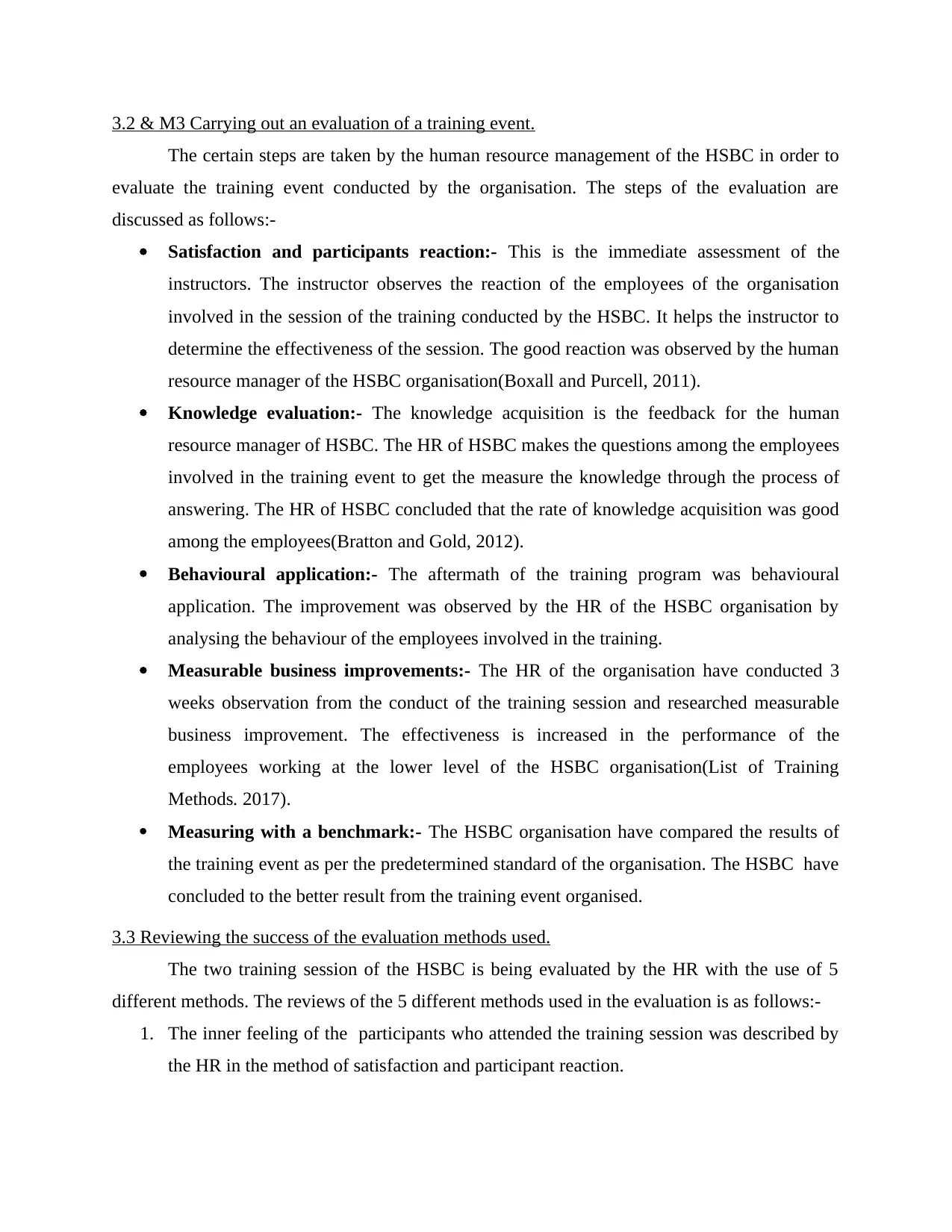
3.2 & M3 Carrying out an evaluation of a training event.
The certain steps are taken by the human resource management of the HSBC in order to
evaluate the training event conducted by the organisation. The steps of the evaluation are
discussed as follows:-
Satisfaction and participants reaction:- This is the immediate assessment of the
instructors. The instructor observes the reaction of the employees of the organisation
involved in the session of the training conducted by the HSBC. It helps the instructor to
determine the effectiveness of the session. The good reaction was observed by the human
resource manager of the HSBC organisation(Boxall and Purcell, 2011).
Knowledge evaluation:- The knowledge acquisition is the feedback for the human
resource manager of HSBC. The HR of HSBC makes the questions among the employees
involved in the training event to get the measure the knowledge through the process of
answering. The HR of HSBC concluded that the rate of knowledge acquisition was good
among the employees(Bratton and Gold, 2012).
Behavioural application:- The aftermath of the training program was behavioural
application. The improvement was observed by the HR of the HSBC organisation by
analysing the behaviour of the employees involved in the training.
Measurable business improvements:- The HR of the organisation have conducted 3
weeks observation from the conduct of the training session and researched measurable
business improvement. The effectiveness is increased in the performance of the
employees working at the lower level of the HSBC organisation(List of Training
Methods. 2017).
Measuring with a benchmark:- The HSBC organisation have compared the results of
the training event as per the predetermined standard of the organisation. The HSBC have
concluded to the better result from the training event organised.
3.3 Reviewing the success of the evaluation methods used.
The two training session of the HSBC is being evaluated by the HR with the use of 5
different methods. The reviews of the 5 different methods used in the evaluation is as follows:-
1. The inner feeling of the participants who attended the training session was described by
the HR in the method of satisfaction and participant reaction.
The certain steps are taken by the human resource management of the HSBC in order to
evaluate the training event conducted by the organisation. The steps of the evaluation are
discussed as follows:-
Satisfaction and participants reaction:- This is the immediate assessment of the
instructors. The instructor observes the reaction of the employees of the organisation
involved in the session of the training conducted by the HSBC. It helps the instructor to
determine the effectiveness of the session. The good reaction was observed by the human
resource manager of the HSBC organisation(Boxall and Purcell, 2011).
Knowledge evaluation:- The knowledge acquisition is the feedback for the human
resource manager of HSBC. The HR of HSBC makes the questions among the employees
involved in the training event to get the measure the knowledge through the process of
answering. The HR of HSBC concluded that the rate of knowledge acquisition was good
among the employees(Bratton and Gold, 2012).
Behavioural application:- The aftermath of the training program was behavioural
application. The improvement was observed by the HR of the HSBC organisation by
analysing the behaviour of the employees involved in the training.
Measurable business improvements:- The HR of the organisation have conducted 3
weeks observation from the conduct of the training session and researched measurable
business improvement. The effectiveness is increased in the performance of the
employees working at the lower level of the HSBC organisation(List of Training
Methods. 2017).
Measuring with a benchmark:- The HSBC organisation have compared the results of
the training event as per the predetermined standard of the organisation. The HSBC have
concluded to the better result from the training event organised.
3.3 Reviewing the success of the evaluation methods used.
The two training session of the HSBC is being evaluated by the HR with the use of 5
different methods. The reviews of the 5 different methods used in the evaluation is as follows:-
1. The inner feeling of the participants who attended the training session was described by
the HR in the method of satisfaction and participant reaction.
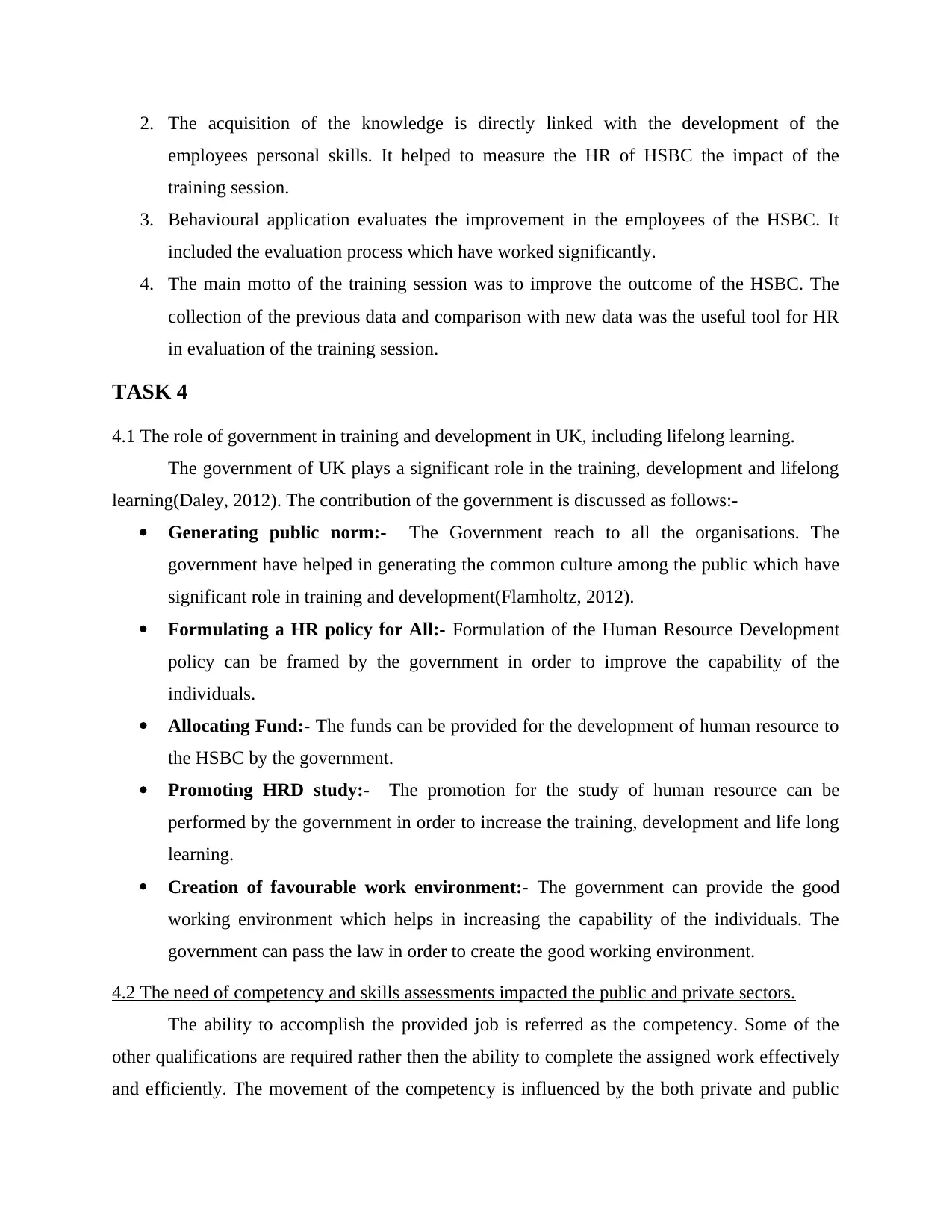
2. The acquisition of the knowledge is directly linked with the development of the
employees personal skills. It helped to measure the HR of HSBC the impact of the
training session.
3. Behavioural application evaluates the improvement in the employees of the HSBC. It
included the evaluation process which have worked significantly.
4. The main motto of the training session was to improve the outcome of the HSBC. The
collection of the previous data and comparison with new data was the useful tool for HR
in evaluation of the training session.
TASK 4
4.1 The role of government in training and development in UK, including lifelong learning.
The government of UK plays a significant role in the training, development and lifelong
learning(Daley, 2012). The contribution of the government is discussed as follows:-
Generating public norm:- The Government reach to all the organisations. The
government have helped in generating the common culture among the public which have
significant role in training and development(Flamholtz, 2012).
Formulating a HR policy for All:- Formulation of the Human Resource Development
policy can be framed by the government in order to improve the capability of the
individuals.
Allocating Fund:- The funds can be provided for the development of human resource to
the HSBC by the government.
Promoting HRD study:- The promotion for the study of human resource can be
performed by the government in order to increase the training, development and life long
learning.
Creation of favourable work environment:- The government can provide the good
working environment which helps in increasing the capability of the individuals. The
government can pass the law in order to create the good working environment.
4.2 The need of competency and skills assessments impacted the public and private sectors.
The ability to accomplish the provided job is referred as the competency. Some of the
other qualifications are required rather then the ability to complete the assigned work effectively
and efficiently. The movement of the competency is influenced by the both private and public
employees personal skills. It helped to measure the HR of HSBC the impact of the
training session.
3. Behavioural application evaluates the improvement in the employees of the HSBC. It
included the evaluation process which have worked significantly.
4. The main motto of the training session was to improve the outcome of the HSBC. The
collection of the previous data and comparison with new data was the useful tool for HR
in evaluation of the training session.
TASK 4
4.1 The role of government in training and development in UK, including lifelong learning.
The government of UK plays a significant role in the training, development and lifelong
learning(Daley, 2012). The contribution of the government is discussed as follows:-
Generating public norm:- The Government reach to all the organisations. The
government have helped in generating the common culture among the public which have
significant role in training and development(Flamholtz, 2012).
Formulating a HR policy for All:- Formulation of the Human Resource Development
policy can be framed by the government in order to improve the capability of the
individuals.
Allocating Fund:- The funds can be provided for the development of human resource to
the HSBC by the government.
Promoting HRD study:- The promotion for the study of human resource can be
performed by the government in order to increase the training, development and life long
learning.
Creation of favourable work environment:- The government can provide the good
working environment which helps in increasing the capability of the individuals. The
government can pass the law in order to create the good working environment.
4.2 The need of competency and skills assessments impacted the public and private sectors.
The ability to accomplish the provided job is referred as the competency. Some of the
other qualifications are required rather then the ability to complete the assigned work effectively
and efficiently. The movement of the competency is influenced by the both private and public
⊘ This is a preview!⊘
Do you want full access?
Subscribe today to unlock all pages.

Trusted by 1+ million students worldwide
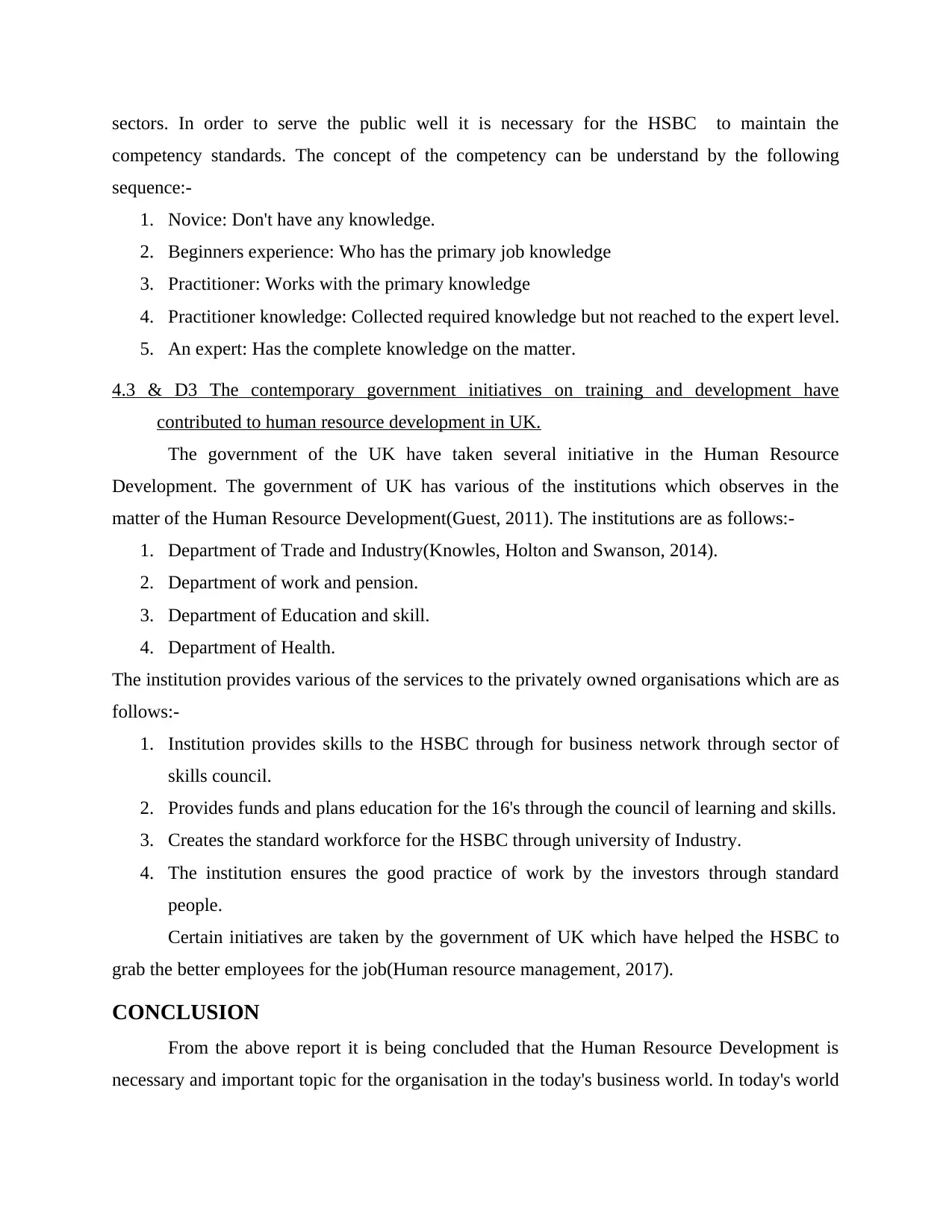
sectors. In order to serve the public well it is necessary for the HSBC to maintain the
competency standards. The concept of the competency can be understand by the following
sequence:-
1. Novice: Don't have any knowledge.
2. Beginners experience: Who has the primary job knowledge
3. Practitioner: Works with the primary knowledge
4. Practitioner knowledge: Collected required knowledge but not reached to the expert level.
5. An expert: Has the complete knowledge on the matter.
4.3 & D3 The contemporary government initiatives on training and development have
contributed to human resource development in UK.
The government of the UK have taken several initiative in the Human Resource
Development. The government of UK has various of the institutions which observes in the
matter of the Human Resource Development(Guest, 2011). The institutions are as follows:-
1. Department of Trade and Industry(Knowles, Holton and Swanson, 2014).
2. Department of work and pension.
3. Department of Education and skill.
4. Department of Health.
The institution provides various of the services to the privately owned organisations which are as
follows:-
1. Institution provides skills to the HSBC through for business network through sector of
skills council.
2. Provides funds and plans education for the 16's through the council of learning and skills.
3. Creates the standard workforce for the HSBC through university of Industry.
4. The institution ensures the good practice of work by the investors through standard
people.
Certain initiatives are taken by the government of UK which have helped the HSBC to
grab the better employees for the job(Human resource management, 2017).
CONCLUSION
From the above report it is being concluded that the Human Resource Development is
necessary and important topic for the organisation in the today's business world. In today's world
competency standards. The concept of the competency can be understand by the following
sequence:-
1. Novice: Don't have any knowledge.
2. Beginners experience: Who has the primary job knowledge
3. Practitioner: Works with the primary knowledge
4. Practitioner knowledge: Collected required knowledge but not reached to the expert level.
5. An expert: Has the complete knowledge on the matter.
4.3 & D3 The contemporary government initiatives on training and development have
contributed to human resource development in UK.
The government of the UK have taken several initiative in the Human Resource
Development. The government of UK has various of the institutions which observes in the
matter of the Human Resource Development(Guest, 2011). The institutions are as follows:-
1. Department of Trade and Industry(Knowles, Holton and Swanson, 2014).
2. Department of work and pension.
3. Department of Education and skill.
4. Department of Health.
The institution provides various of the services to the privately owned organisations which are as
follows:-
1. Institution provides skills to the HSBC through for business network through sector of
skills council.
2. Provides funds and plans education for the 16's through the council of learning and skills.
3. Creates the standard workforce for the HSBC through university of Industry.
4. The institution ensures the good practice of work by the investors through standard
people.
Certain initiatives are taken by the government of UK which have helped the HSBC to
grab the better employees for the job(Human resource management, 2017).
CONCLUSION
From the above report it is being concluded that the Human Resource Development is
necessary and important topic for the organisation in the today's business world. In today's world
Paraphrase This Document
Need a fresh take? Get an instant paraphrase of this document with our AI Paraphraser

the HRD has many concepts and studies. The HRD help the individual to increase the ability of
the individual to compete for the job.
the individual to compete for the job.
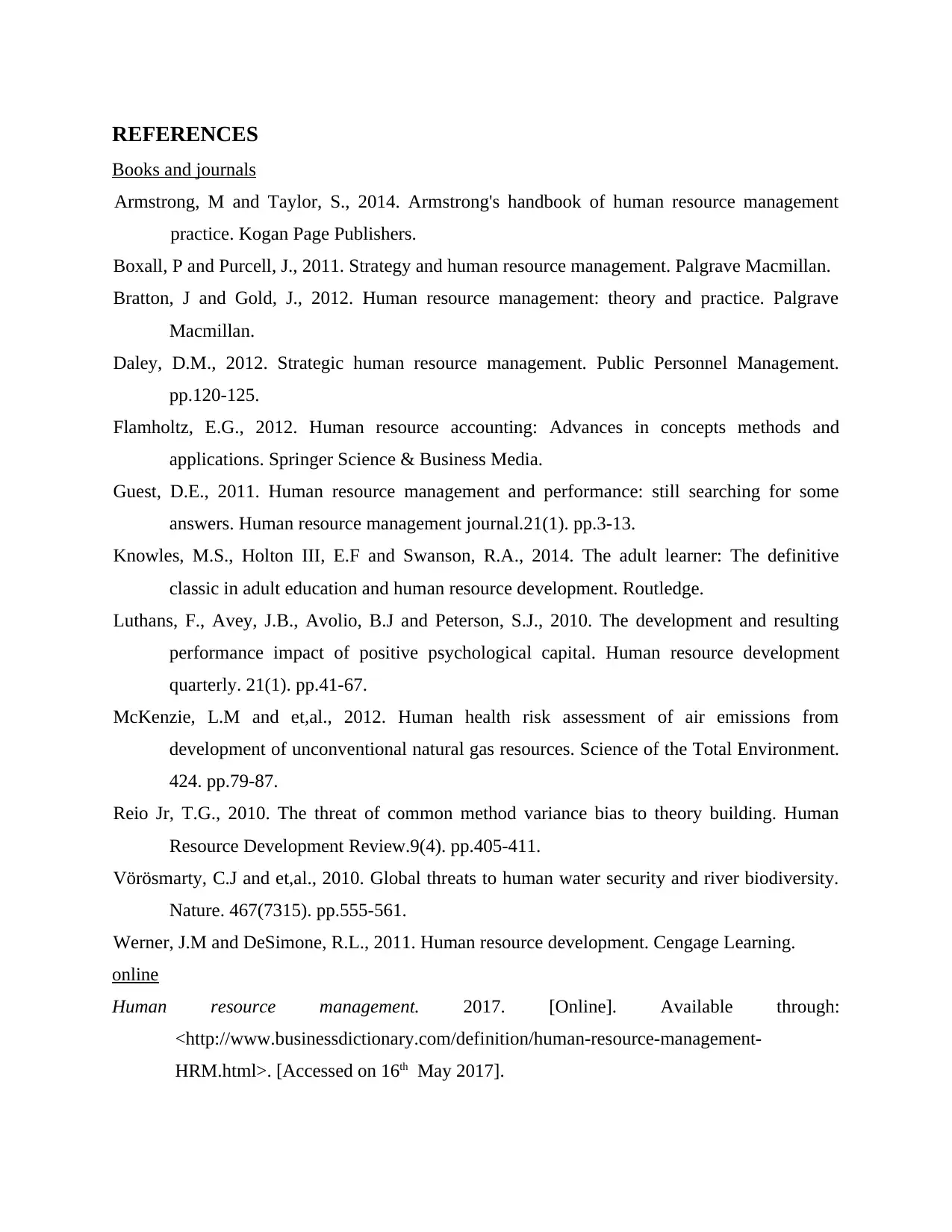
REFERENCES
Books and journals
Armstrong, M and Taylor, S., 2014. Armstrong's handbook of human resource management
practice. Kogan Page Publishers.
Boxall, P and Purcell, J., 2011. Strategy and human resource management. Palgrave Macmillan.
Bratton, J and Gold, J., 2012. Human resource management: theory and practice. Palgrave
Macmillan.
Daley, D.M., 2012. Strategic human resource management. Public Personnel Management.
pp.120-125.
Flamholtz, E.G., 2012. Human resource accounting: Advances in concepts methods and
applications. Springer Science & Business Media.
Guest, D.E., 2011. Human resource management and performance: still searching for some
answers. Human resource management journal.21(1). pp.3-13.
Knowles, M.S., Holton III, E.F and Swanson, R.A., 2014. The adult learner: The definitive
classic in adult education and human resource development. Routledge.
Luthans, F., Avey, J.B., Avolio, B.J and Peterson, S.J., 2010. The development and resulting
performance impact of positive psychological capital. Human resource development
quarterly. 21(1). pp.41-67.
McKenzie, L.M and et,al., 2012. Human health risk assessment of air emissions from
development of unconventional natural gas resources. Science of the Total Environment.
424. pp.79-87.
Reio Jr, T.G., 2010. The threat of common method variance bias to theory building. Human
Resource Development Review.9(4). pp.405-411.
Vörösmarty, C.J and et,al., 2010. Global threats to human water security and river biodiversity.
Nature. 467(7315). pp.555-561.
Werner, J.M and DeSimone, R.L., 2011. Human resource development. Cengage Learning.
online
Human resource management. 2017. [Online]. Available through:
<http://www.businessdictionary.com/definition/human-resource-management-
HRM.html>. [Accessed on 16th May 2017].
Books and journals
Armstrong, M and Taylor, S., 2014. Armstrong's handbook of human resource management
practice. Kogan Page Publishers.
Boxall, P and Purcell, J., 2011. Strategy and human resource management. Palgrave Macmillan.
Bratton, J and Gold, J., 2012. Human resource management: theory and practice. Palgrave
Macmillan.
Daley, D.M., 2012. Strategic human resource management. Public Personnel Management.
pp.120-125.
Flamholtz, E.G., 2012. Human resource accounting: Advances in concepts methods and
applications. Springer Science & Business Media.
Guest, D.E., 2011. Human resource management and performance: still searching for some
answers. Human resource management journal.21(1). pp.3-13.
Knowles, M.S., Holton III, E.F and Swanson, R.A., 2014. The adult learner: The definitive
classic in adult education and human resource development. Routledge.
Luthans, F., Avey, J.B., Avolio, B.J and Peterson, S.J., 2010. The development and resulting
performance impact of positive psychological capital. Human resource development
quarterly. 21(1). pp.41-67.
McKenzie, L.M and et,al., 2012. Human health risk assessment of air emissions from
development of unconventional natural gas resources. Science of the Total Environment.
424. pp.79-87.
Reio Jr, T.G., 2010. The threat of common method variance bias to theory building. Human
Resource Development Review.9(4). pp.405-411.
Vörösmarty, C.J and et,al., 2010. Global threats to human water security and river biodiversity.
Nature. 467(7315). pp.555-561.
Werner, J.M and DeSimone, R.L., 2011. Human resource development. Cengage Learning.
online
Human resource management. 2017. [Online]. Available through:
<http://www.businessdictionary.com/definition/human-resource-management-
HRM.html>. [Accessed on 16th May 2017].
⊘ This is a preview!⊘
Do you want full access?
Subscribe today to unlock all pages.

Trusted by 1+ million students worldwide

List of Training Methods. 2017. [Online]. Available through:
<https://www.hr.com/en/communities/training_and_development/list-of-training-
methods_eacwezdm.html>. [Accessed on 16th May 2017].
<https://www.hr.com/en/communities/training_and_development/list-of-training-
methods_eacwezdm.html>. [Accessed on 16th May 2017].
1 out of 16
Related Documents
Your All-in-One AI-Powered Toolkit for Academic Success.
+13062052269
info@desklib.com
Available 24*7 on WhatsApp / Email
![[object Object]](/_next/static/media/star-bottom.7253800d.svg)
Unlock your academic potential
© 2024 | Zucol Services PVT LTD | All rights reserved.





